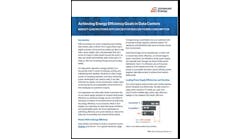In a vote of confidence on the future of software-defined power, Virtual Power Systems (VPS) has named industry visionary Dean Nelson as its permanent CEO and raised $12 million in additional funding to advance its technology to disrupt data center electrical infrastructure.
Nelson, who was named interim CEO of VPS after a shakeup in February, has been a leading advocate of the potential for software-defined power to lower costs and improve efficiency in data centers. Nelson has driven more than $10 billion in infrastructure projects across three continents for Sun Microsystems, eBay and Uber, and is founder and chairman of leading data center industry group Infrastructure Masons.
“We are fortunate to have Dean Nelson leading Virtual Power Systems (VPS) at a time when data centers are recognizing the critical need to utilize Software-Defined Power,” said Peter Gross, VPS’ Chairman of the Board and himself a pioneer in data center power design. “As permanent CEO, we are excited to continue to benefit from his stewardship, vision and exemplary track record of driving industry-leading technology teams.”
Virtual Power Systems is a startup that offers software, hardware appliances and lithium-ion batteries to optimize power distribution within a data center. As with server virtualization, software-defined power offers the promise of bringing new levels of efficiency and automation to data centers. That includes reallocating power from underused racks to IT gear that needs additional power.
VPS uses a combination of software and distributed batteries to conduct peak shaving, using the batteries to store power and allocate it to the system when needed, creating a more elastic system for distributing power. The batteries and power flows are managed by the company’s software suite, which allocates power from by utility sources, UPS systems and batteries.
VPS has worked primarily with lithium-ion batteries, but the company has also recently begun working with sodium-ion technology from Natron Energy, which offers the potential to pack more capacity in a smaller footprint, as well as faster recharging.
“I am honored and excited for the opportunity to lead Virtual Power Systems,” said Dean Nelson, VPS’ CEO. “The COVID-19 pandemic has highlighted the world’s dependency on digital infrastructure and the corresponding explosion of data and data center capacity demand. We are laser-focused on helping our customers significantly increase utilization by unlocking stranded power that reduces costs and simultaneously increases resiliency. I look forward to working with the board and the incredibly talented VPS team to advance the adoption of Software-Defined Power.”
The additional $12 million in capital brings the total investment in VPS to $46 million. The funding will be used to expand the team, and develops products and partnerships to support the company’s hardware and software platform.






